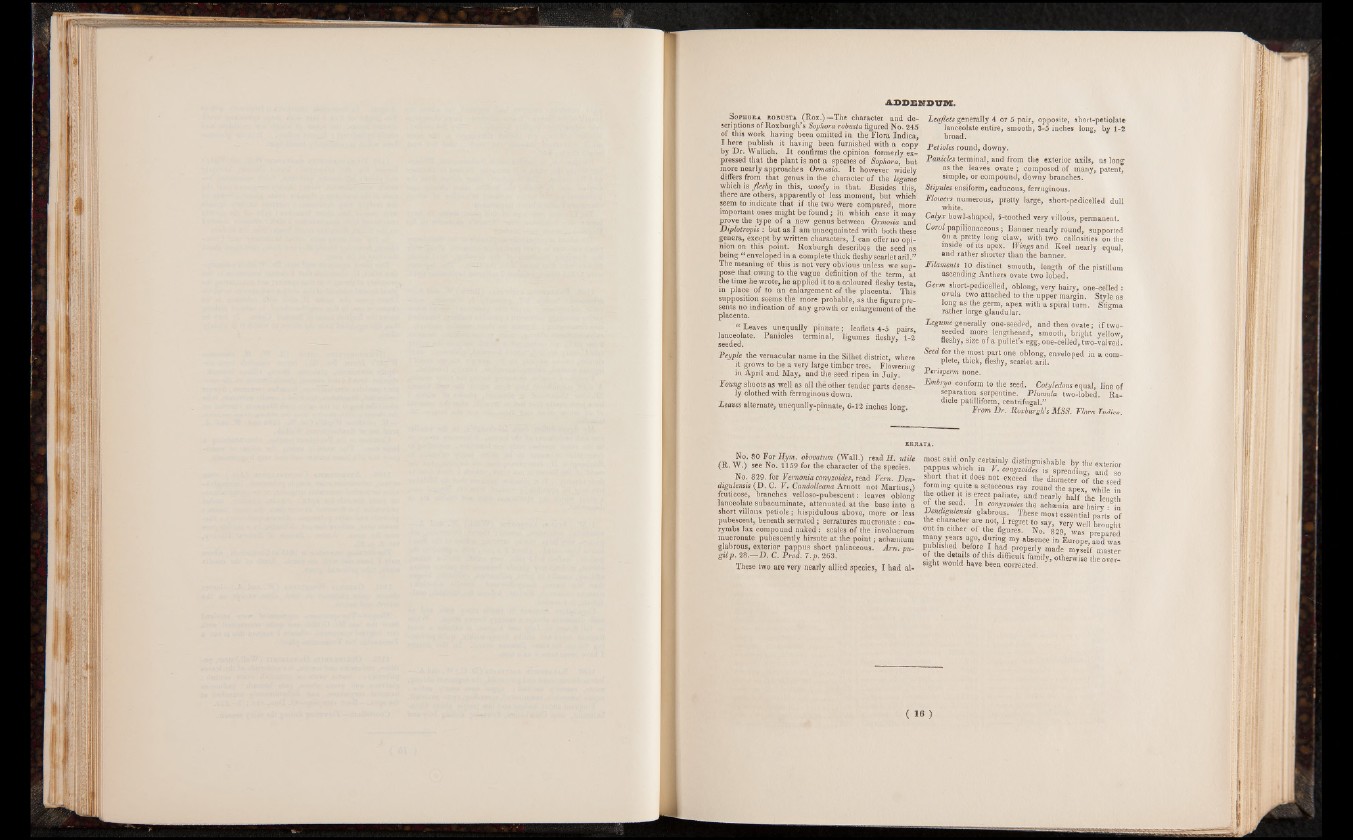
A D D E N D U M .
Sophora robusta (Rox.)—The character and descriptions
of Roxburgh's Sophora robusta figured No. 245
of this work having been omitted in the Flora Indica,
I here publish it having been furnished with a copy
by Dr. Wallich. It confirms the opinion formerly expressed
that the plant is not a species of Sophora, but
more nearly approaches Ormosia. It however widely
differs from that genus in the character of the legume
which is fleshy in this, woody in that. Besides this,
there are others, apparently of less moment, but which
seem to indicate that if the two were compared, more
important ones might be found; in which case it may
prove the type of a new genus between Ormosia and
Diplotropis : but as I am unacquainted with both these
genera, except by written characters, I can offer no opinion
on this point. Roxburgh describes the seed as
being “ enveloped in a complete thick fleshy scarlet aril."
The meaning of this is not very obvious unless we suppose
that owing to the vague definition of the term, at
the time he wrote, he applied it to a coloured fleshy testa,
in place of to an enlargement of the placenta. This
supposition seems the more probable, as the figure presents
no indication of any growth or enlargement of the
placenta.
“ Leaves unequally pinnate; leaflets 4-5 pairs,
lanceolate. Panicles terminal, ligumes fleshy, 1-2
seeded.
Peyple the vernacular name in the Silhet district, where
it grows to be a very large timber tree. Flowering
!^:,'in April and May, and the seed ripen in July.
Young shoots as well as all the other tender parts densely
clothed with ferruginous down.
Leaves alternate, unequally-pinnate, 6-12 inches long.
Leaflets generally 4 or 5 pair, opposite, short-petiolate
lanceolate entire, smooth, 3-5 inches long, by 1-2
broad.
Petioles round, downy.
Panicles terminal, and from the exterior axils, as long
as the leaves ovate ; composed of many, patent,
simple, or compound, downy branches.
Stipules ensiform, caducous, ferruginous.
Flowers numerous, pretty large, short-pedicelled dull
white.
Calyx bowl-shaped, 5-toothed very villous, permanent.
Corol papilionaceous; Banner nearly round, supported
6n a pretty long claw, with two callosities on the
inside of its apex. tVings and Keel nearly equal,
and rather shorter than the banner.
Filaments 10 distinct smooth, length of the pistillum
ascending Anthers ovate two lobed.
Germ short-pedicelled, oblong, very hairy, one-celled :
ovula two attached to the upper margin. Style as
long as the germ, apex with a spiral turn. Stigma
rather large glaudular.
Legume generally one-seeded, and then ovate; if two-
seeded more lengthened, smooth, bright yellow,
fleshy, size of a pullet's egg, one-celled, two-valved.
Seed for the most part one oblong, enveloped in a complete,
thick, fleshy, scarlet aril.
Perisperm none.
Embryo conform to the seed. Cotyledons equal, line of
separation serpentine. Plumula two-lobed. Radicle
patilliform, centrifugal.''
From Dr. Roxburgh’s MSS. Flora Indica.
ZRRATA.
No. 80 For Hym. obovatum (Wall.) read H. utile
(R. W.) see No. 1159 for the character of the species.
No. 829. for Vemonia conyzoides, read Vem. Den-
digulensis (D. C. V. Candolleana Arnott not Martius,)
fruticose, branches velloso-pubescent: leaves oblong
lanceolate subacuminate, attenuated at the base into a
short villous petiole; hispidulous above, more or less
pubescent, beneath serrated; serratures mucronatecorymbs
lax compound naked : scales of the involucrum
mucronate pubescently hirsute at the point; achaenium
glabrous, exterior pappus short paliaceous. Am. pu~
gilp. 28.—D. C. Prod. 7.p. 263.
These two are very nearly allied species, I had almost
said only certainly distinguishable by the exterior
pappus which m V. conyzoides is spreading, and so
short that it does not exceed the diameter of the seed
forming quite a setaceous ray round the apex, while in
the other it IS erect paliate, and nearly half the length
of the seed. In conyzoides the achatnia are hairy -gin
Dendignlensu glabrous. These most essential parts of
the character are not, I regret to say, Tery well brought
out in either of the figures. No. 829, was prepared
many years ago, during my absence in Europe, and was
published before I had properly made myself master
of the details of this difficult family, otherwise the over-
sight would have been corrected.